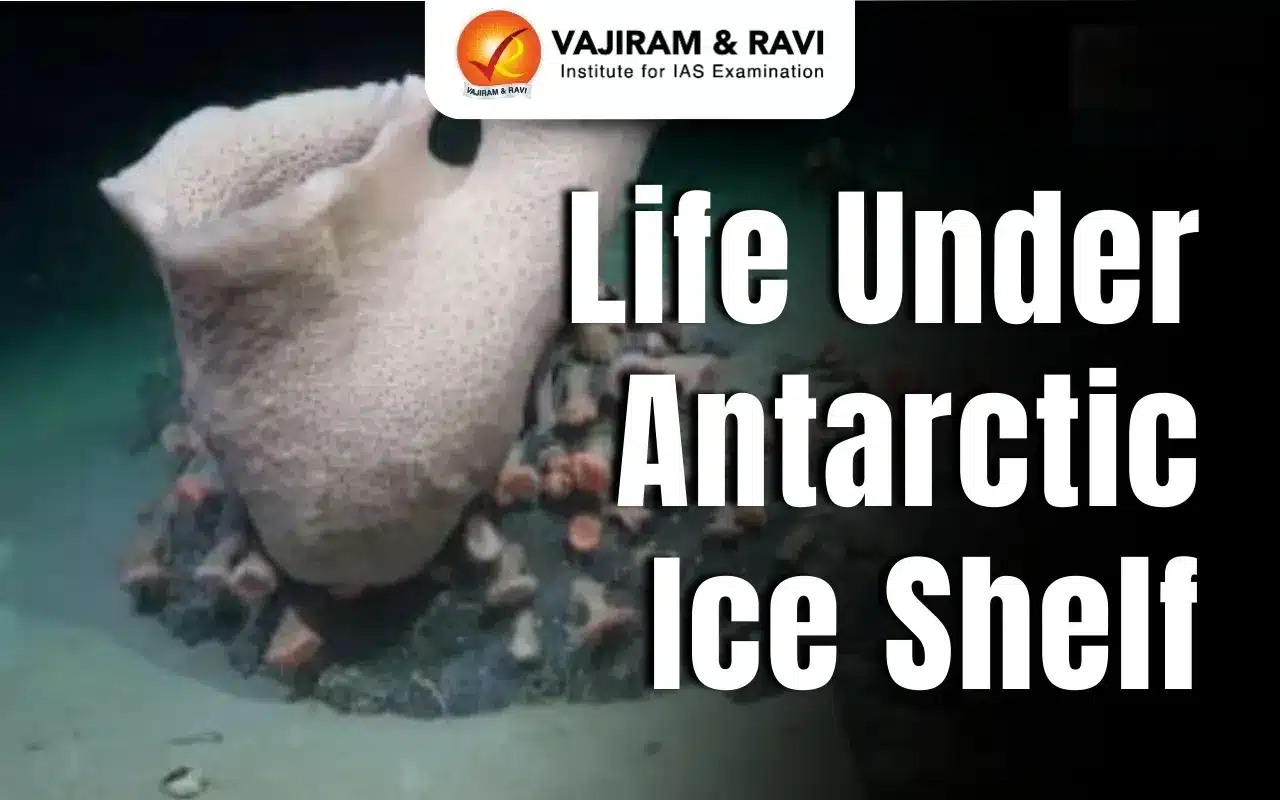Life under the Antarctic Ice Shelf Latest News
Scientists have discovered dozens of new species on the newly exposed seafloor left behind by the A-84 iceberg, which broke away from the George VI Ice Shelf on January 13, 2025.
What is an Ice Shelf?
- An ice shelf is a floating mass of glacial ice, fed from land by tributary glaciers, and extending over the sea above an ice shelf cavity.
- Key Ice Sheets:
- Antarctica and Greenland Ice Sheets hold two-thirds of Earth’s freshwater.
- The West Antarctic Ice Sheet is one of the largest.
- Role in Sea Level Changes:
- When ice sheets gain mass, global sea levels fall.
- When ice sheets lose mass, global sea levels rise.
Scientific Discoveries Under George VI Ice Shelf
- Expedition: Conducted as part of Challenger 150, a UNESCO-endorsed global deep-sea research initiative.
- Remotely Operated Vehicle (ROV) SuBastian explored the seabed 1,300 meters deep.
- Key findings:
- Diverse ecosystem: Found icefish, giant sea spiders, corals, sponges, and octopi.
- New species: Scientists believe they discovered previously unknown marine species.
- Jellyfish discovery: A giant phantom jelly was recorded, growing up to a meter wide.
- Unusual nutrient supply: Despite being cut off from surface nutrients for centuries, life thrives—possibly due to ocean currents or glacial meltwater transporting essential nutrients.
About George VI Ice Shelf
- Location: Lies between Alexander Island and the Antarctic Peninsula.
- Size: Covers 24,000 sq. km, making it the second-largest ice shelf in the region.
- Ice flow: Receives ice from both the Antarctic Peninsula and Alexander Island.
- Unlike most ice shelves, it is laterally constrained (trapped between landmasses) instead of freely flowing into the ocean.
- It blocks epishelf lakes (trapped freshwater bodies between ice shelves and land).
- Situated at the -9°C mean annual air temperature isotherm, a critical threshold beyond which ice shelves are prone to collapse.
- Susceptible to melting from both atmospheric warming and warm ocean currents.
Life under the Antarctic Ice Shelf FAQs
Q1. What is an Antarctic Ice Shelf?
Ans. An ice shelf is a floating extension of a glacier or ice sheet that forms where the ice flows from the land into the ocean. These shelves are attached to the continent but extend over the sea.
Q2. Why are Antarctic Ice Shelves important?
Ans. Ice shelves act as barriers, slowing the flow of glaciers into the ocean. Their stability is crucial for maintaining sea levels and regulating ocean currents.
Q3. What is the impact of ice shelf collapse on sea levels?
Ans. Ice shelves themselves do not raise sea levels when they melt since they are already floating. However, their collapse can speed up glacier movement, leading to a rise in global sea levels.
Q4. What are some major Antarctic Ice Shelves?
Ans. Ross Ice Shelf (largest in Antarctica), Ronne Ice Shelf, Larsen Ice Shelf (Larsen A, B, and C have experienced major collapses), Filchner Ice Shelf and Amery Ice Shelf.
Source: IE
Last updated on January, 2026
→ Check out the latest UPSC Syllabus 2026 here.
→ Join Vajiram & Ravi’s Interview Guidance Programme for expert help to crack your final UPSC stage.
→ UPSC Mains Result 2025 is now out.
→ UPSC Notification 2026 is scheduled to be released on January 14, 2026.
→ UPSC Calendar 2026 is released on 15th May, 2025.
→ UPSC Prelims 2026 will be conducted on 24th May, 2026 & UPSC Mains 2026 will be conducted on 21st August 2026.
→ The UPSC Selection Process is of 3 stages-Prelims, Mains and Interview.
→ UPSC Result 2024 is released with latest UPSC Marksheet 2024. Check Now!
→ UPSC Toppers List 2024 is released now. Shakti Dubey is UPSC AIR 1 2024 Topper.
→ Also check Best IAS Coaching in Delhi

















